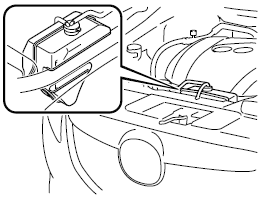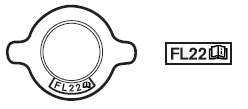Mazda CX-5 Owners Manual: Engine Coolant
Inspecting Coolant Level
WARNING
Do not use a match or live flame in the engine compartment. DO NOT ADD COOLANT WHEN THE ENGINE IS HOT:
A hot engine is dangerous. If the engine has been running, parts of the engine compartment can become very hot. You could be burned.
Carefully inspect the engine coolant in the coolant reservoir, but do not open it.

Switch the ignition to off and make sure the fan is not running before attempting to work near the cooling fan:
Working near the cooling fan when it is running is dangerous. The fan could continue running indefinitely even if the engine has stopped and the engine compartment temperature is high. You could be hit by the fan and seriously injured.

Do not remove either cooling system cap when the engine and radiator are hot:
When the engine and radiator are hot, scalding coolant and steam may shoot out under pressure and cause serious injury.
NOTE
Changing the coolant should be done by an Authorized Mazda Dealer.
Inspect the antifreeze protection and coolant level in the coolant reservoir at least once a year―at the beginning of the winter season―and before traveling where temperatures may drop below freezing.
Inspect the condition and connections of all cooling system and heater hoses.
Replace any that are swollen or deteriorated.
The coolant should be at full in the radiator and between the F and L marks on the coolant reservoir when the engine is cool.

If it is at or near L, add enough coolant to the coolant reservoir to provide freezing and corrosion protection and to bring the level to F.
Securely tighten the coolant reservoir tank cap after adding coolant.
CAUTION
●Radiator coolant will damage paint.
Rinse it off quickly if spilled.
● Use only soft (demineralized) water in the coolant mixture.
Water that contains minerals will cut down on the coolant's effectiveness.
● Do not add only water. Always add a proper coolant mixture.
● The engine has aluminum parts and must be protected by an ethylene-glycol-based coolant to prevent corrosion and freezing.
● DO NOT USE coolants Containing Alcohol, methanol, Borate or Silicate.
These coolants could damage the cooling system.
● DO NOT MIX alcohol or methanol with the coolant. This could damage the cooling system.
● Do not use a solution that contains more than 60% antifreeze.
This would reduce effectiveness.
NOTE
If the “FL22” mark is shown on or near the cooling system cap, it is recommended to use Mazda Genuine FL22 engine coolant .

If the coolant reservoir is empty or new coolant is required frequently, consult an Authorized Mazda Dealer.
 Engine Oil
Engine Oil
NOTE
Changing the engine oil should be performed by an Authorized Mazda Dealer.
Refer to Introduction for owner's responsibility in protecting your investment.
Recommended Oil
U.S.A. and ...
 Brake/Clutch Fluid
Brake/Clutch Fluid
Inspecting Brake/Clutch Fluid Level
The brakes and clutch draw fluid from the same reservoir.
Inspect the fluid level in the reservoir regularly. It should be kept at MAX.
The level normally drops ...
Other materials:
Blind Spot Monitoring (Bsm) Control Module Removal/Installation
1. Disconnect the negative battery cable..
2. Remove the rear combination light..
3. Remove the rear bumper..
4. Disconnect the connector.
5. Remove the nuts.
6. Remove the BSM control module.
7. Install in the reverse order of removal.
8. Perform the BSM radar test..
CAUTION:
...
Cruise Control
Cruise Control
With cruise control, you can set and automatically maintain any speed of more
than about 25 km/h (16 mph).
WARNING
Do not use the cruise control under the following conditions: Using the cruise
control under the following conditions is dangerous and could result in loss of
ve ...
Driver Side Air Bag Module [Standard Deployment Control System]
Purpose
When the driver-side air bag module receives an impact from a frontal or
frontal offset collision, the operation (deployment) of the air bag mediates
the impact to the head and face of the driver.
Function
When the driver-side air bag module receives an impact from ...
